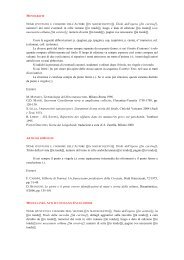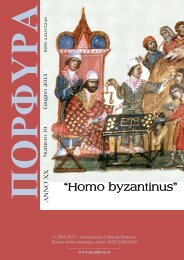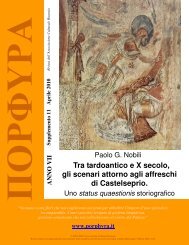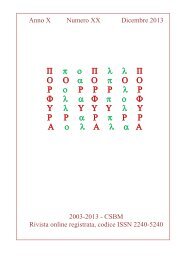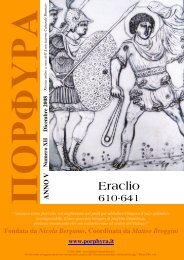ΠΟΡΦΥΡΑ - Porphyra
ΠΟΡΦΥΡΑ - Porphyra
ΠΟΡΦΥΡΑ - Porphyra
Create successful ePaper yourself
Turn your PDF publications into a flip-book with our unique Google optimized e-Paper software.
A Prôtospatharios, Magistros, and Strategos Autokrator of 11 th cent.<br />
the equipment of Georgios Maniakes and his army according to the Skylitzes Matritensis miniatures<br />
and other artistic sources of the middle Byzantine period.<br />
φακεολιs) was worn by Officers, associated with the<br />
ηκατονταρκοs 214 or similar rank in other regiments 215 .<br />
Such kind of hood was probably linked back behind the<br />
nape with a knock 216 ; in the source the thongs joining it, stitched<br />
upon its extrem lemb, are hanging over the linen damask cloak.<br />
So we have reconstructed it loosen (plate 1B), richly<br />
embroidered on the upper part. Silk embroidered helmet covers<br />
or cloth helmets belongs to an East-Roman military tradition<br />
dating from beginning of the 7 th century, probably due to the<br />
influence of Sassanid Persians and Steppe People 217 .<br />
The mantle of the man, in the cloisonné of Munchen (fig.<br />
10), is deep blue with a purple borders, internal blue lining and<br />
gold-red agrafhes. The cloak (chlamis) was typical for all<br />
officers 218 but this one is enriched by a purple edge which<br />
reveals to us the very high status of the owner. The Varangians<br />
loved such things, as is revealed by a description of the<br />
Varangian Bolli Bollason returning to Scandinavia from<br />
Constantinople : “....He wore cloths of velvet which the Emperor<br />
had given him, and over them a cloak of fine red cloth ; at his<br />
side he bore his sword Fòtbìtr (footbiter) ; his hilt was inlaid<br />
with gold, and so was the blade ; he wore a golden helmet and<br />
had a red shield at his side on which was drawn a knight in gold<br />
(which he had brought from Byzantium)...” 219 At breast height<br />
the cloak of our officer was probably decorated by a square<br />
cloth embroidery (tablion) 220 stitched upon it, inside which we<br />
214 100 men’s commander, the old Roman centurion, in 10 th cent. vice-commander of the military unit called Vàndon :<br />
Leo, Taktika, IV, 11 ; in Praecepta Militaria I, 1, commander of 100 men in his infantry κουντουβερνιον ; idem in<br />
Taktika of Nikephoros Ouranos, I, 1, in McGeer, Showing..., p. 89, and idem, p. 204, 266-267, 333.<br />
215 Ian Heath speaks of a association of this kind of headgear with the Jews in Byzantine art. It is true that in a lot of<br />
processions representing the entry of Jesus in Jerusalem the notables of the city wear a very similar head dress but this<br />
does not mean that it is an identification of the Jews in the Eastern Empire. In any case in the representation of<br />
Longinus we have an image of a Roman Officer so that any link with the Jews is out. See Heath, Byzantine armies, p.<br />
26.<br />
216 Cfr. Heath I., Armies and Enemies of the Crusades, 1096-1291, WRGP, Worthing, 1978, p. 98.<br />
217 For silk helmets cover see the warriors represented on the 7th David Plates from Cyprus representing the clash<br />
among David and Goliath, cfr. Nicolle D., The Battle of Yarmuk 636, London 1994 pp. 18-19; the 10 th century Joshua<br />
represented on the fresco of Cavusin, see note 71 above; the cover of the helmets worn by Jewish soldiers in the<br />
Vatican Gr. 333 folio 36v, 11 th century, in Lassus J., L’illustration, fig. 69.; for silk headgear covering a probable felt<br />
padded protection worn without helmet s. the πρωτοσπαθαριοι eunuchs represented in the fragment of ivory casket in<br />
Munchen, in Kolias, Waffen, pl. IX, 2; the archers in a 10 th cent. fresco from Aghios Eustachios, Kappadokia, in<br />
Grabar, Bisanzio, L’arte bizantina del Medioevo dall’VIII al XV secolo, Milano 1964, p. 149; the Alan and Turkish<br />
warriors of Caucasus were wearing such a headgear since the 8 th century see Nicolle, Attila and the Nomad Hordes, pp.<br />
60-61 and plate H1; for under helmets hoods worn by Sassanians warriors see Nicolle, Sassanian Armies, p. 43 pl. E3;<br />
Nicolle, Byzantine and Islamic, p. 311 and figures.<br />
218 See notes 62 and 131 above.<br />
219 In the Laxdala Saga ; s. Blondal, The Varangians, pp. 206-207.<br />
220 The ταβλιον (from latin tabula) was a decorative squared cloth application to the mantle of officers and dignitaries,<br />
since from the Constantine age. It was a symbol of the rank and made of different colour and design, from the Emperor<br />
to the last dignitary. It was made of precious cloth often embroidered, sometimes interwoven with golden thread. See<br />
Wessel, Insignien, for the imperial ταβλιον, pp. 427-428; for officers ταβλια of this age see the Kletorologion of<br />
Philotheos, in Oikonomidès, Les listes, pp. 95, 127, 133 and n. 98 ; De Cer., I, 440;Reiske, Commentarii de Cerimoniis,<br />
pp. 44, 107, 228, 471-472 ; Ebersolt, Mélanges, pp. 55-56 ; Du Cange, Glossarium, col. 1520. For a beautiful<br />
representation of the tablion of imperial officer in 10-11 th century s. Aghios Philadelphos in the Menologium of Basil<br />
II, in Ravegnani G., La corte di Bisanzio, Rimini 1984, fig. 29 p. 64.<br />
36



